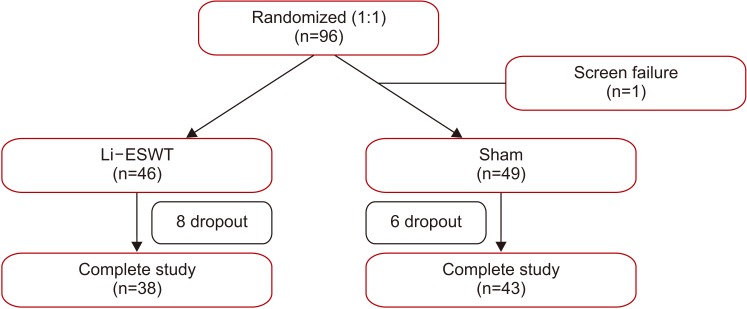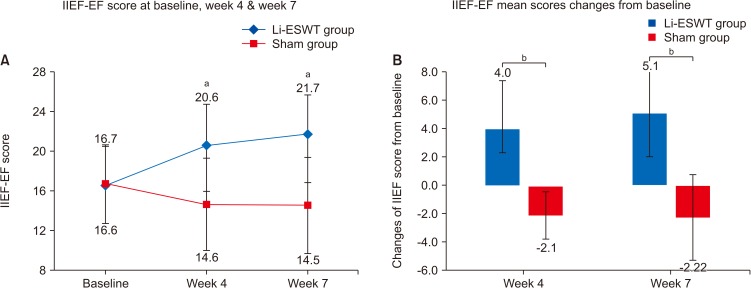World J Mens Health.
2020 Apr;38(2):236-242. 10.5534/wjmh.190130.
Electromagnetic Low-Intensity Extracorporeal Shock Wave Therapy in Patients with Erectile Dysfunction: A Sham-Controlled, Double-Blind, Randomized Prospective Study
- Affiliations
-
- 1Department of Urology, Incheon St. Mary's Hospital, College of Medicine, The Catholic University of Korea, Seoul, Korea.
- 2Department of Urology, Kangdong Sacred Heart Hospital, Hallym University College of Medicine, Seoul, Korea.
- 3Department of Urology, Yeouido St. Mary's Hospital, College of Medicine, The Catholic University of Korea, Seoul, Korea.
- 4Department of Urology, Eunpyeong St. Mary's Hospital, College of Medicine, The Catholic University of Korea, Seoul, Korea.
- 5Department of Urology, Seoul St. Mary's Hospital, College of Medicine, The Catholic University of Korea, Seoul, Korea. ksw1227@catholic.ac.kr, bwoong@catholic.ac.kr
- 6Department of Urology, Hanyang University College of Medicine, Seoul, Korea.
- 7Department of Urology, Korea University College of Medicine, Seoul, Korea.
- 8Catholic Integrative Medicine Research Institute, College of Medicine, The Catholic University of Korea, Seoul, Korea.
- KMID: 2471830
- DOI: http://doi.org/10.5534/wjmh.190130
Abstract
- PURPOSE
The aim of the present study was to evaluate the efficacy and safety of the electromagnetic-type low-intensity extracorporeal shock wave therapy (Li-ESWT) in patients with erectile dysfunction (ED).
MATERIALS AND METHODS
The randomized, sham-controlled, double-blind prospective study was performed at two referral hospitals. Participants were randomized in a 1:1 ratio to receive sham or Li-ESWT for 6 weeks. ED was evaluated at screening and at 4 and 7 weeks after treatment. Participants were asked to complete the international index of erectile function-erectile function (IIEF-EF) domain questionnaire, erection hardness scale (EHS), and sexual encounter profile questionnaire (SEPQ 2 and 3). The development of complications was investigated.
RESULTS
Eighty-one of 96 patients completed the study. The median change in the IIEF-EF score in the Li-ESWT and sham groups was 5.1 and −2.2 (p<0.001), respectively, at the 7-week follow-up; 47.4% (18/38) patients had EHS <3, of which 77.8% (14/18) showed significant improvement in virtue of Li-ESWT treatment (p=0.001). A significant improvement was observed in the percentage of "Yes" responses to SEPQ 2 and 3 in the Li-ESWT group vs. sham group from baseline to 7-week follow-up (91.3% vs. 69.4%; p=0.008 and 50.0% vs. 14.3%; p=0.002, respectively). No patients reported pain or other adverse events during treatment or follow-up.
CONCLUSIONS
Thus, Li-ESWT could have a role in improving erectile function. Furthermore, it is safe. We believe that Li-ESWT is an attractive new treatment modality for patients with ED.
Keyword
MeSH Terms
Figure
Reference
-
1. NIH Consensus Conference. Impotence. NIH Consensus Development Panel on Impotence. JAMA. 1993; 270:83–90. PMID: 8510302.2. Rajfer J, Aliotta PJ, Steidle CP, Fitch WP 3rd, Zhao Y, Yu A. Tadalafil dosed once a day in men with erectile dysfunction: a randomized, double-blind, placebo-controlled study in the US. Int J Impot Res. 2007; 19:95–103. PMID: 16871272.
Article3. Hatzimouratidis K, Amar E, Eardley I, Giuliano F, Hatzichristou D, Montorsi F, et al. European Association of Urology. Guidelines on male sexual dysfunction: erectile dysfunction and premature ejaculation. Eur Urol. 2010; 57:804–814. PMID: 20189712.
Article4. Schuüller J, Chaussy C. [A new therapy for urinary calculi. Noninvasive kidney stone crushing]. Krankenpfl Soins Infirm. 1984; 77:30–31. German.5. Al-Abbad H, Simon JV. The effectiveness of extracorporeal shock wave therapy on chronic achilles tendinopathy: a systematic review. Foot Ankle Int. 2013; 34:33–41. PMID: 23386759.6. Ito K, Fukumoto Y, Shimokawa H. Extracorporeal shock wave therapy for ischemic cardiovascular disorders. Am J Cardiovasc Drugs. 2011; 11:295–302. PMID: 21846155.
Article7. Lu Z, Lin G, Reed-Maldonado A, Wang C, Lee YC, Lue TF. Low-intensity extracorporeal shock wave treatment improves erectile function: a systematic review and meta-analysis. Eur Urol. 2017; 71:223–233. PMID: 27321373.
Article8. Gruenwald I, Appel B, Kitrey ND, Vardi Y. Shockwave treatment of erectile dysfunction. Ther Adv Urol. 2013; 5:95–99. PMID: 23554844.
Article9. Lei H, Liu J, Li H, Wang L, Xu Y, Tian W, et al. Low-intensity shock wave therapy and its application to erectile dysfunction. World J Mens Health. 2013; 31:208–214. PMID: 24459653.
Article10. Li H, Matheu MP, Sun F, Wang L, Sanford MT, Ning H, et al. Low-energy shock wave therapy ameliorates erectile dysfunction in a pelvic neurovascular injuries rat model. J Sex Med. 2016; 13:22–32. PMID: 26755082.
Article11. Nishida T, Shimokawa H, Oi K, Tatewaki H, Uwatoku T, Abe K, et al. Extracorporeal cardiac shock wave therapy markedly ameliorates ischemia-induced myocardial dysfunction in pigs in vivo. Circulation. 2004; 110:3055–3061. PMID: 15520304.
Article12. Cappelleri JC, Rosen RC, Smith MD, Mishra A, Osterloh IH. Diagnostic evaluation of the erectile function domain of the International Index of Erectile Function. Urology. 1999; 54:346–351. PMID: 10443736.
Article13. Vardi Y, Appel B, Kilchevsky A, Gruenwald I. Does low intensity extracorporeal shock wave therapy have a physiological effect on erectile function? Short-term results of a randomized, double-blind, sham controlled study. J Urol. 2012; 187:1769–1775. PMID: 22425129.
Article14. Aicher A, Heeschen C, Sasaki K, Urbich C, Zeiher AM, Dimmeler S. Low-energy shock wave for enhancing recruitment of endothelial progenitor cells: a new modality to increase efficacy of cell therapy in chronic hind limb ischemia. Circulation. 2006; 114:2823–2830. PMID: 17145991.15. Vardi Y, Appel B, Jacob G, Massarwi O, Gruenwald I. Can low-intensity extracorporeal shockwave therapy improve erectile function? A 6-month follow-up pilot study in patients with organic erectile dysfunction. Eur Urol. 2010; 58:243–248. PMID: 20451317.
Article16. Zou ZJ, Tang LY, Liu ZH, Liang JY, Zhang RC, Wang YJ, et al. Short-term efficacy and safety of low-intensity extracorporeal shock wave therapy in erectile dysfunction: a systematic review and meta-analysis. Int Braz J Urol. 2017; 43:805–821. PMID: 28379665.
Article17. Sokolakis I, Hatzichristodoulou G. Clinical studies on low intensity extracorporeal shockwave therapy for erectile dysfunction: a systematic review and meta-analysis of randomised controlled trials. Int J Impot Res. 2019; 31:177–194. PMID: 30664671.
Article18. Ogden JA, Tóth-Kischkat A, Schultheiss R. Principles of shock wave therapy. Clin Orthop Relat Res. 2001; (387):8–17. PMID: 11400898.
Article19. Jeong HC, Jeon SH, Qun ZG, Kim KS, Choi SW, Bashraheel F, et al. Effects of next-generation low-energy extracorporeal shockwave therapy on erectile dysfunction in an animal model of diabetes. World J Mens Health. 2017; 35:186–195. PMID: 29164834.
Article20. Zhu GQ, Jeon SH, Bae WJ, Choi SW, Jeong HC, Kim KS, et al. Efficient promotion of autophagy and angiogenesis using mesenchymal stem cell therapy enhanced by the low-energy shock waves in the treatment of erectile dysfunction. Stem Cells Int. 2018; 2018:1302672. PMID: 30228820.
Article21. Jeong HC, Bae WJ, Zhu GQ, Jeon SH, Choi SW, Kim SJ, et al. Synergistic effects of extracorporeal shockwave therapy and modified Ojayeonjonghwan on erectile dysfunction in an animal model of diabetes. Investig Clin Urol. 2019; 60:285–294.
Article
- Full Text Links
- Actions
-
Cited
- CITED
-
- Close
- Share
- Similar articles
-
- Penile Low-Intensity Shock Wave Therapy: A Promising Novel Modality for Erectile Dysfunction
- Adjuvant daily therapy with L-arginine 2,500 mg and tadalafil 5 mg increases efficacy and duration of benefits of low-intensity extracorporeal shock wave therapy for erectile dysfunction: A prospective, randomized, single-blinded study with 1-year follow-up
- Efficacy of Low-Intensity Extracorporeal Shock Wave Therapy for the Treatment of Chronic Pelvic Pain Syndrome IIIb: A Prospective-Randomized, Double-Blind, Placebo-Controlled Study
- Clinical Practice Guideline Recommendation on the Use of Low Intensity Extracorporeal Shock Wave Therapy and Low Intensity Pulsed Ultrasound Shock Wave Therapy to Treat Erectile Dysfunction:The Asia-Pacific Society for Sexual Medicine Position Statement
- Efficacy of extracorporeal shock wave therapy for pillar pain after open carpal tunnel release: a double-blind, randomized, sham-controlled study



